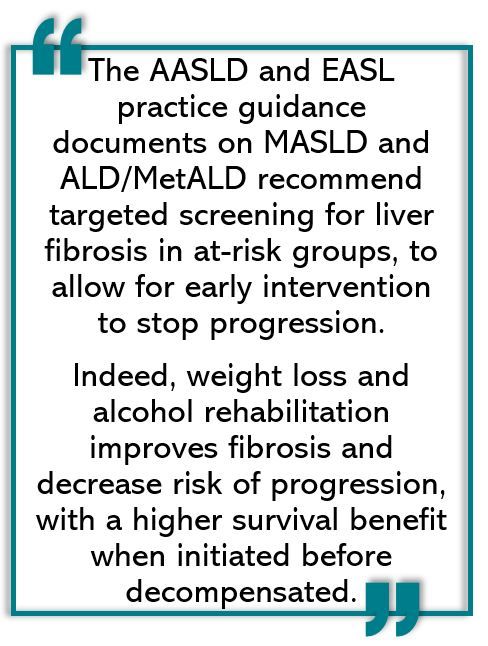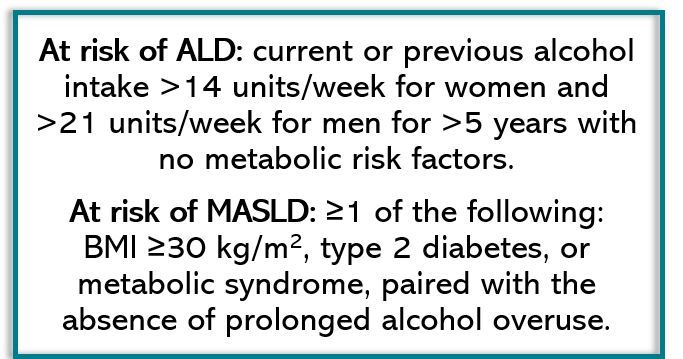Fibrosis Screening Results May Motivate Behavior Change in Adults at Risk of Liver Disease: Danish Study

Among individuals at risk of alcohol-related liver disease (ALD) or metabolic dysfunction-associated steatotic liver disease (MASLD) clinical screening for liver fibrosis may serve as a catalyst for critical behavior change including reduced alcohol consumption and weight loss according to new research from investigators in Denmark.
In part, their prospective cohort study of more than 4000 community dwelling adults at risk of either ALD or MASLD found that at 6 months following a positive result for liver fibrosis, excessive alcohol consumption fell from 46% to 32% among participants at risk of ALD; among participants at risk of MASLD, more than one-third had improved diet composition and 13% self-reported weight loss of 5% or more.
The researchers noted that while self-reported lifestyle changes were more pronounced in screening positive participants, they were not limited to this group.
“Advice based on biological markers has been effective in other fields such as respiratory medicine. In liver disease, few studies have investigated whether knowledge on liver disease can be used as a tool to initiate lifestyle changes, but they are limited by small sample sizes and high attrition rates,” wrote Maria Kjaergaard, MD, of the department of gastroenterology and hepatology at Odense University Hospital in Denmark, and colleagues in Clinical Gastroenterology and Hepatology.
Kjaergaard and team set out to examine short- and long-term consequences among individuals at risk of ALD or MASLD after receiving results of transient elastography (TE) screening for liver fibrosis. Results were evaluated based on self-reported changes in alcohol, diet, exercise, and weight.
Investigators recruited participants from the general population aged 30 to 75 years who had risk factors for ALD, MetALD, or MASLD, excluding those with known chronic liver disease, cancer, or other diseases with an expected survival of less than 1 year, according to the study. Recruitment relied on random personal invitations and community calls.

Following enrollment, researchers screened participants for liver fibrosis using TE (FibroScan). They assessed lifestyle factors including diet, exercise, current and previous alcohol use and administered the Alcohol Use Disorder Identification Test (AUDIT) through an electronic questionnaire. Participants with positive screening results attended another visit within 3 months for repeat investigations and liver biopsy to grade and stage hepatic disease.
Participants received written/oral screening results, and all were given standardized lifestyle advice, regardless of findings. One week later and again after 6 months, all participants received an electronic questionnaire on self-reported changes in alcohol consumption, diet, physical activity, and weight.
FINDINGS
Of an initial group of 46 277 invited to participate between October 2017 and October 2022, 4796 qualified for inclusion: 1850 were determined to be at risk of ALD and 2946 were at risk of MASLD. More than half (52%) of participants were men and the median age was 58 years. Kjaergaard et al identified 184 (10%) positive screening participants in the ALD group and 199 (7%) in the MASLD group, based on TE ≥8 kPa. The 1-week questionnaire was completed by 87% of participants and by 84% responded to the 6-month questionnaire.
Alcohol-related liver disease
In the group of ALD participants, most reported reducing average alcohol consumption immediately after screening and through 6 months of follow-up. Investigators found that self-reported excessive drinking in this group decreased from 46% to 32% after 6 months and was more pronounced among those who had screened positive.
A positive screening test was associated with abstinence/decreased alcohol use after 6 months (odds ratio [OR], 1.82; 95% CI, 1.26-2.64; P = .001), findings that also were most pronounced in participants with high-risk drinking at baseline (OR, 2.45; 95% CI, 1.32-4.57; P = .005), according to the study.
At a 2-year post-screening follow up, investigators reductions in weekly drinks were sustained in 577 participants at risk of ALD. Only screening-positive individuals retained lower drinking habits, however, and a positive screening test predicted abstinence or decreased alcohol use after 2 years (OR, 1.84; 95% CI, 1.09-3.11; P = .023).
Metabolic dysfunction-associated steatotic liver disease
In the MASLD group, researchers also observed self-reported improvements after participants received screening results. At 1 week, 26% reported decreased calorie intake and/or a healthier diet and 35% reported the same after 6 months (P < .001). As in the ALD group, the positive finding was more pronounced among screening-positive participants (45%) than screening-negative participants (32%; P = .007). Of interest, only 3% reported increased or unhealthier dietary habits after 6 months.
After 1 week, 12% of the MASLD group reported increased exercise levels, a figure that increased to 22% after 6 months (P <.001). More screening-positive participants increased their exercise after 1 week than screening negatives (P = .045), but there was no difference after 6 months (P = .773).
“A screening programme may combine early detection of advanced fibrosis with increased motivation to lifestyle changes, and may consequently act as both prevention, early detection, and part of the treatment,” investigators concluded.